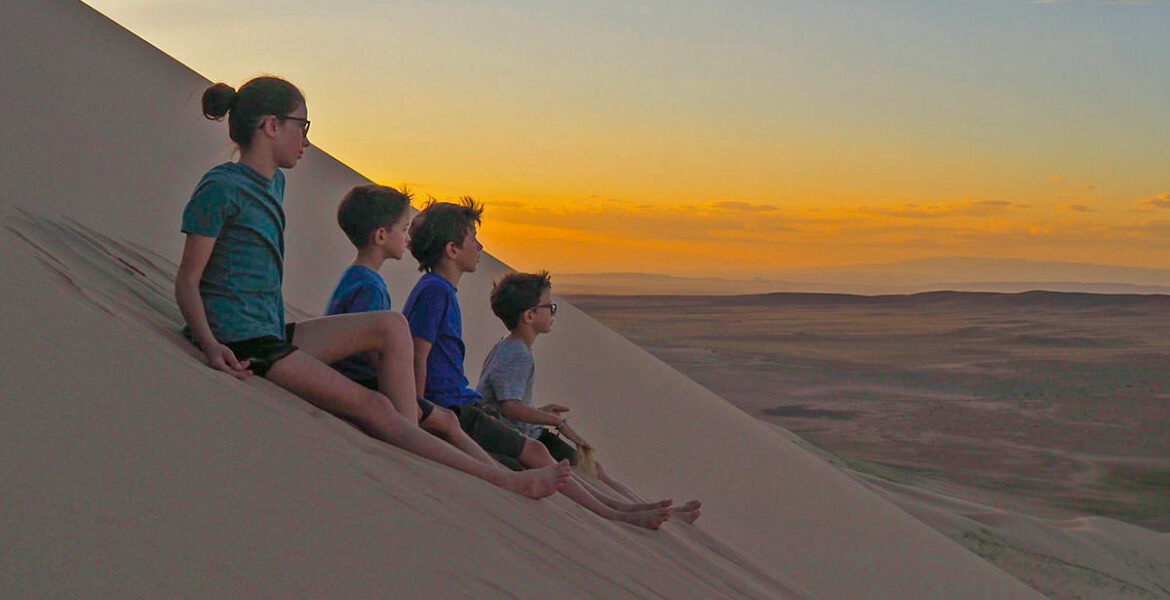Their minivan was driving through the non-existing roads of Mongolia, passing through places most of us will never see. Out of the blue, the five-year-old Laurent popped a straightforward question before Edith Lemay: “Mommy, what does it mean to be blind?”
Edith Lemay and Sebastien Pelletier took their family on a voyage of a lifetime. Faced with the diagnosis that will make three of their four children blind when they reach adulthood, these fierce Canadian parents decided not to go into despair, but instead live life to the fullest on an around-the-world trip they would all remember.
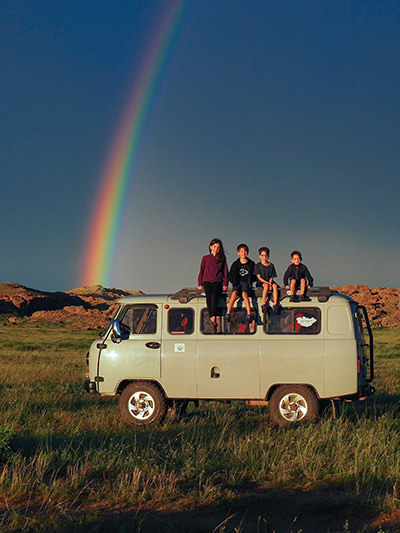
But while the older kids, already familiar with many doctor visits, knew what it meant to lose vision, Edith Lemay suddenly realized that the youngest passenger of this unique journey didn’t fully understand it.
“It’s like keeping your eyes closed all the time, Laurent”, Edith said.
Miles away from his hometown of Montreal, the curious five-year-old had a billion questions troubling his little head. “How will I cross the street? How will I drive a car? Will my wife be blind, mommy?”
The river of question marks poured over Edith Lemay while she tried to gather both herself and facts in portraying the situation as non-problematic.
“I tried to answer as matter-of-factly as possible. ‘There is a solution’, I said. ‘It’s normal, it’s not a problem…’ But inside, I was crushed. It was a really hard moment for me”, Edith recalls.
Edith Lemay and Sebastien Pelletier – love at first sight?
Exactly eight decades before this conversation in the Mongolian outback, in the middle of the Second World War, another curious Quebecoise boy was asking a billion questions. The listening adult engaged in this 1942 conversation was Antoine de Saint-Exupéry.
If the French writer had not visited Montreal and met the inquisitive Canadian boy, maybe he would have never written the story about the little prince traveling the universe and addressing the topics of love and loss in a world where grown-ups fail to see the important things.
The fox was the one sharing the wisdom with the boy: “It is only with the heart that one can see rightly; what is essential is invisible to the eye.”
Edith Lemay (44) and Sebastien Pelletier (45) have been together for 14 years, even if their pathways crossed 24 years ago. They saw each other back at the university but remained invisible.
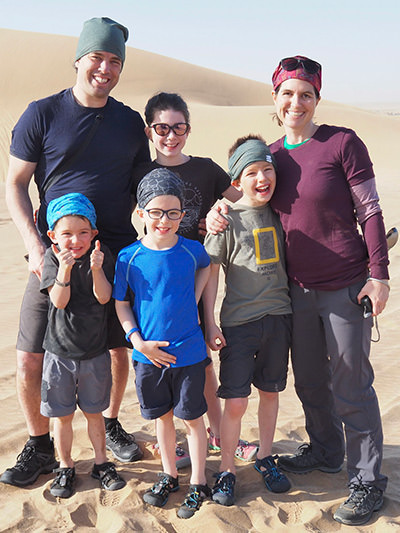
“We went to the same school, we knew the same people, but we didn’t really talk to each other. We were probably not at the same place in life, and pretty different”, Edith describes the times when she caught first glimpses of a man who would become her future husband.
It took an improbable online meeting ten years after college, to say the truly profound “I see you”, in a way that the Na’vi tribe greets each other on Avatar’s Pandora. “When we finally met, we were like soul mates.”
This was not just an unusual encounter between two souls who almost missed each other. After they started building their family, Edith and Sebastien would find out they were the source of a genetically-transferred disease that could activate only if both parents carried the gene.
“I have never heard of retinitis pigmentosa. Nobody had it in our families”, Edith Lemay says. “Both mum and dad need to have defective genes, so it is pretty rare. You really need to be unlucky to get it. Even if both of us have a gene, we statistically only have a 1-in-4 chance to transmit it. Well, it ended up being 3 out of 4.”
Due to retinitis pigmentosa, this rare genetic disorder that makes cells in the eye retina break down over time, Mia (11), Colin (7) and Laurent (5) will be slowly losing their vision as they become adults. Only Leo (9) was lucky enough to escape the genetic destiny.
Tom Turcich embarked on his world journey after losing a friend and being faced with questions of his own mortality. He decided to become the tenth person to walk around the world!
Filling the children’s visual memory
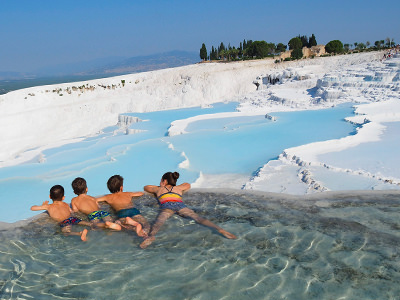
“When I have a problem and bad things happen in life, my way of coping is to spring into action. And the thing with this diagnosis is that there is nothing you can do. The doctor tells you ‘Well, your kids are going to be blind, but we can’t do anything about it, so see you in a year’. That was really hard for me”, Edith Lemay explains.
For a professional working in logistics, mainly in healthcare but also for the fantasy factory Cirque du Soleil, solving problems was an everyday challenge. Suddenly, she faced a process she was not able to improve.
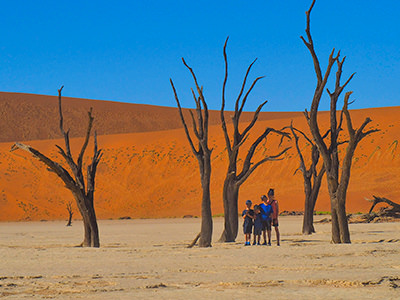
“Before the pandemic, my job was to make things run smoother in Cirque du Soleil, a really great job. I would take a process that is not working well, and try to make it better. But the pandemic hit, and it almost closed down, so everybody lost their jobs”, Edith explains.
Luckily, her other half was in a better position at the time. Sebastien worked in finances, in management of a small company that got bought by a larger one, so he cashed in his shares. That amount of money was enough to pay for the trip around the world, in which they would follow the professional’s advice to “fill the visual memory” of their kids losing eyesight.
“For us, this money was a sign, just a nice big gift from life, telling us ‘you can go and live your dream’”, Edith says.
They rented out their Montreal house for 9 months, and in March 2022, off they went. Namibia, Zambia, Tanzania, Turkey, Mongolia, Bali…
Even the pandemic couldn't stop another resilient Canadian in his quest to conquer the world by - sailing alone around it! Meet Bert terHart!
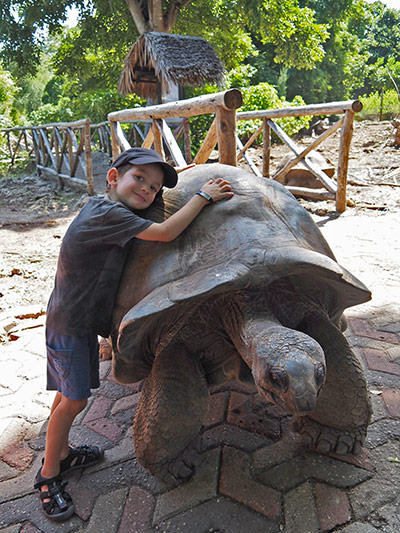
Bucket list of things to do during the voyage
When traveling the world, many of us are chasing sights recommended by tour guides, those neverending lists of “things to see” here and there.
Lemay-Pelletier family initially also started with a well-planned itinerary. They had to leave in July 2020, cross Russia with the Trans-Siberian train, go to Mongolia, China… But then the pandemic happened, and they were redoing their plans countless times.
In the end, when the countries started opening up, they left without an itinerary. Africa seemed pretty open, and that’s where they started. Nowadays, they only plan a month ahead.
More than with things to see, this sight-losing family filled their itinerary with things to do, the activities they would like to experience during their trip.
Edith Lemay agreed to share her family’s voyage bucket list with Pipeaway’s readers.
Edith Lemay's family voyage bucket list
1. To go on a safari 2. See the Great Wall of China 3. Sleep on a train 4. See Pokemon 5. Swim with dolphins and/or whales 6. Do a multi-day trek 7. See a sunrise over a mountain 8. Learn to surf 9. See an Aurora Borealis 10. Bathe in a hot spring 11. Take the Trans-Siberian train 12. Eat with chopsticks 13. Ride a horse in Mongolia 14. Collect sunset photos 15. Make friends in other countries 16. Learn new languages 17. Sleep on a boat 18. Drink juice on a camel 19. Eat unknown fruits 20. Snorkel with tropical fish 21. Visit colorful markets 22. Visit a castle 23. Visit a boat museum 24. Go ziplining 25. Take a cruise on a river 26. See hot-air balloons in Cappadocia 27. Take a plane 28. Eat ice-cream
Already in the planning phase, the Canadian family obviously cherished the experience of being together, finding beauty in the most simple things.
They were just in southern Lombok, Indonesia, when we started our interview, with dog barks, catfights, and imam’s call for prayer in the background.
Do you want explore Lombok yourself? Consider Hotel Tugu Lombok as your base, one of the most romantic places to stay on the island!
Beauty is everywhere
Are you happy with where your trip took you so far?
We soon realized that it doesn’t matter where we go, everywhere is beautiful. Every country has nice landscapes and beautiful places to see. We just want to travel and let the adventure surprise us.
One thing our kids will lose is that wide field of vision, so we are trying to stay in nature, in these big, nice, wide open spaces.
But also, what we realized, kids being kids, they really live in the moment. They don’t do this trip with their urgency to keep memories. They are just enjoying the moment. And often they show us beautiful things.
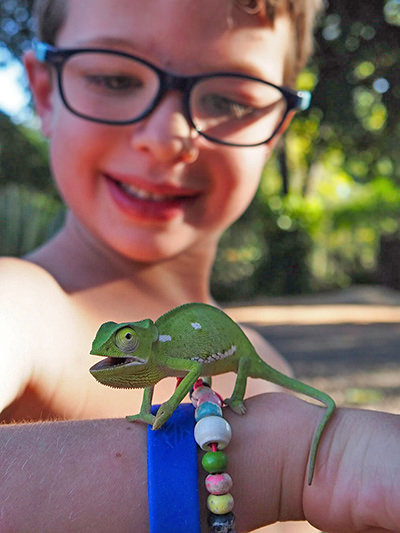
Like, we could take them to see some magnificent temple, and we want them to look at it, but they will see a cute stray cat, and for them, that’s going to be the most beautiful thing of their day.
And it’s okay. Because they also teach us, the beauty from their eyes, what they find beautiful, is just as important as what we think is beautiful.
Yes, puppies can be a real distraction when seeing the wonders of the world!
Exactly, puppies, or even beetles! When we were in Namibia, we visited these amazing sand dunes in Sossusvlei. Laurent was so fascinated with their little black beetles they call toktokkie. He played with these black bugs that walk on sand, and he thought it was the most interesting thing in the world.
At the end of the day, we asked him what he liked, and he said – toktokkie. Oh my god, we take you to these amazing places, we climb one of the highest sand dunes in the world, and what do you do? You care about toktokkie!
But you know, they show us the beauty of the world. Beauty can be anywhere. So we need to be open to how they see the world and learn from it.
The curse of the bright light
At the sand dunes, it must have been nice to enjoy the sunrise!
No, they didn’t enjoy it. We had to wake them up really early, actually before sunrise. A desert at night gets pretty cold. And climbing a sand dune is really hard. It was windy like crazy, you actually get sandblasted.
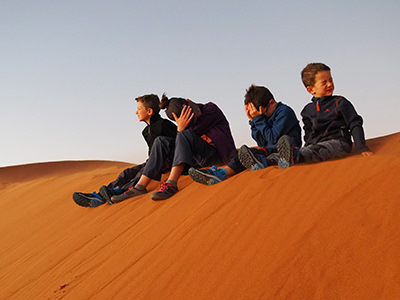
We got to the top of it, and I sat down thinking I would take these beautiful pictures of them looking at the sunrise, but actually, it was so windy they were covering and hiding. They didn’t even watch the sunrise, it was so uncomfortable due to the sand, but also light, as they are sensitive to bright light.
It was a bit stupid for me to think they would watch the sunrise, it wasn’t the best idea. But it made for funny pictures.
And they had lots of fun going down. They actually ran and rolled down in the sands, and loved it. But after the sunrise.
How much can your children see at this moment?
Their daytime vision is super good. Their field of vision is good. But at night, right now, they don’t have night vision. So whenever the light goes down, they can’t see, way before us. They get totally blind. So if at night you go out, and there is little light, they won’t be able to see anything.
Also, my daughter is really sensitive to bright light. So when she is in the sun, she always needs to wear a hat and cover her eyes. Whenever she goes from outside to inside, if it is really bright outside, it takes a long time for her eyes to adjust.
Can your children see the stars?
No. Just a few bright ones.
Disability didn't stop Slaven Škrobot from traveling either. Check out what traveling in a wheelchair looks like!
The future crumbled in the blink of an eye
Mia was the first one to get the diagnosis. How did you find out about it?
It all started when she was about three years old. We realized something was wrong with her vision. During the night, she would get up and start bumping into furniture or walls.
Because it was our first kid, we didn’t really know it was a problem. But after a while, I realized something wasn’t adding up. I would hand her something in dim light, and she wasn’t able to see it while I was able to see it really well.
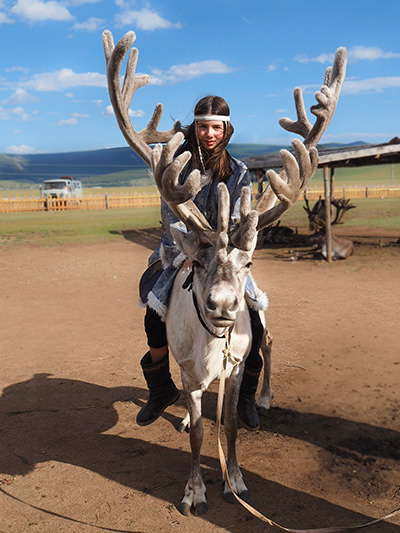
I took her to the optometrist and ophthalmologist for a check-up, but it’s not something we can see in the eyes in the early stage of the disease.
So they sent us to do some genetic testing. After the first panel of genetics, it came back and it was all negative. They didn’t know what she had.
But there was a research protocol at the time, so they did the whole genome for Mia, me, and Sebastien. It took almost two years before we received the results. Mia was seven when we got the diagnosis.
Finding out it’s not curable, did it push you to despair at first?
Our first reaction was disbelief and shock. When you have kids, you just have an idea of how their future’s going to look like, what our lives are going to look like. And all of a sudden, in a blink of an eye, you need to rethink all that. It is a grieving process.
So at first, you don’t believe it’s true, you think it’s a mistake. And then you get angry, you are looking for answers everywhere, get sad… But after a while, you just have to accept it. And it’s only when you accept it, you can move forward.
Elephant in the room
How did you move forward?
I started thinking about what could I do, and one thing I thought would be good for my daughter is to provide her with some tools to help her in the future. And I thought she could actually learn Braille at school, so she would already be able to read once she loses her vision.
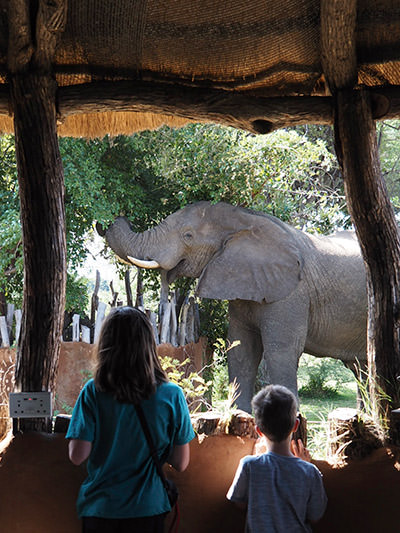
But at school, the specialist told me that they didn’t have all the resources, that she was not blind enough, and her vision was too good to learn Braille properly so that the best thing for me to do would be to actually fill her visual memory.
And she said: “You know, put as much image in her head as you can. For example, you can look at elephants or giraffes in the books, so once she is blind, she’ll have an image to refer to.”
That’s when it clicked to me. Let’s go and show her elephants and giraffes in real life, that way she will really remember it!
And from that, Seb and I just decided that we might as well do it all in, just go to see the world and show them how beautiful the world is. We wanted to fill their visual memory with as many beautiful things as we could.
This American veteran is also traveling the world with her family, in a converted school bus. Meet Jessica Rambo!
Telling your daughter she is going to get blind
Parents often have to support fairytales of the global world we live in, from Santa Claus to the Tooth Fairy. How does it look when you have to present a truth that is not so bright to your children, as you obviously want them to be prepared for what would come?
The really hard thing about the diagnosis was not knowing whether I should tell her or not. I would ask people around me for advice. Some would say: “No, don’t tell her, she doesn’t have important symptoms, let her be a kid, and not worry about it”. Others said: “It’s better that she knows now, it’s easier”. It was really, really hard for me to make a decision on whether or not I would tell her.
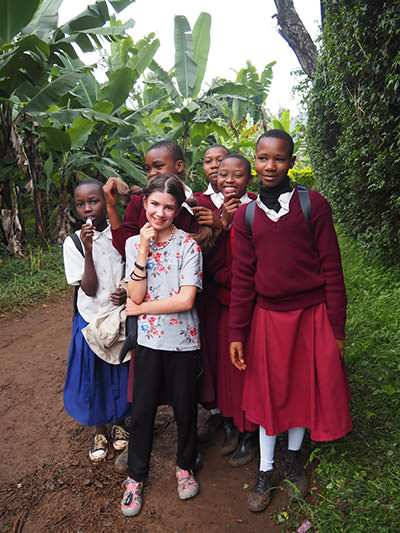
But after a while, knowing my daughter, I decided it is best for her to know right away. I didn’t want to hide anything from her, and she resented me afterward. I knew she was strong enough to get that information.
I didn’t plan it, but at one lunchtime I was sitting with her and it came to the subject of disabilities. And I told her just like that, matter-of-factly: “You know the problem with your eyes, you know you will probably get blind once you are an adult”.
She thought about it for a moment, and then she said: “Oh, well, that’s not fun.” And that was the extent of her reaction.
Coping with the fact that our future might be more or less sightless would be hard for anyone, not only a 7-year-old!
At first, I thought that maybe she didn’t really understand what I was saying, but after a few days she got back to me and said: “Mommy, you know what, I think I have to keep my room clean because once I lose my vision, I need to be able to find my things, so they need to always be at the same place.” I realized that she was already thinking about the solution.
After that, I saw her a couple of times trying to get from one room in the house to the other, keeping her eyes closed. I was reassured that she did understand what was happening and she was just finding some solution on her own.
When people ask her how she feels today, she will say: “Well, today is today. My vision is good, so I will make the most out of it, and I’ll rise to the challenges when they’re there, but right now I’m just enjoying my life.” And I think it’s a good way to see it.
Disabled passengers encounter numerous challenges when flying. Canada's major airline seems to struggle a lot with issues of accessibility. Check out how Air Canada deals with disability!
Things to see before your eyes die
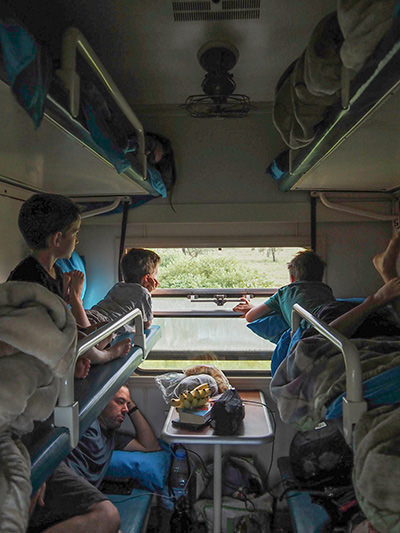
There are numerous lists of “things to see before you die”. Obviously, your family’s bucket list testifies that even when facing the toughest challenges, we can find greatness in small things.
More than things to see, we made a bucket list of activities we wanted to do during the trip because we didn’t know what we would see besides nice, beautiful places.
Mia really wanted to go horseback riding on the wide steppe of Mongolia. She was so happy and excited when it finally happened. When she got down from her horse, she was all teary-eyed because it was so emotional. It was such a great moment for her.
Colin’s best moment was in Tazara, the Tanzania-Zambia Railway, as he really wanted to sleep on the train. It’s a 24-hour ride that we took through Tanzania, and it’s a really old slow train so it was amazing. It would stop at all these different train stations, people would come up to the window and sell us bananas. And just sleeping on the train while it was rocking us, was really a cool moment of the trip.
Leo wanted to see Pokemons, but that might not happen. He thought Pokemons would be living in the wilderness of Japan. He also wanted to go to see the Great Wall of China, but that’s not going to happen either. His favorite moment so far was on a little hike we did on the foot of Kilimanjaro. The vegetation was so amazing, it was a really nice hike in the misty jungle.
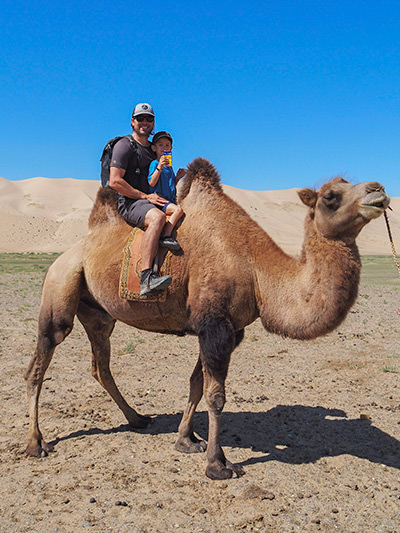
My daughter got to see a dolphin. Seeing giraffes and elephants, we did that. The whole family enjoyed the safari. Kids were so excited to see wild animals in real life. They were very impressed with how tall the giraffe was from close up, and the same for the elephants. Safari is definitely the highlight of our trip.
As for Laurent, he wanted to drink juice on a camel. He was 4 at the time when he made the request, but he was really specific. It was not about seeing a camel, he wanted to drink juice on a camel.
Wait, just any type of juice?!
Yeah, any. It became a kind of an inside joke, we would talk about it all the time because it was really funny. And he actually got to ride a camel, and of course, he made sure he had his juice. So these were funny moments for us.
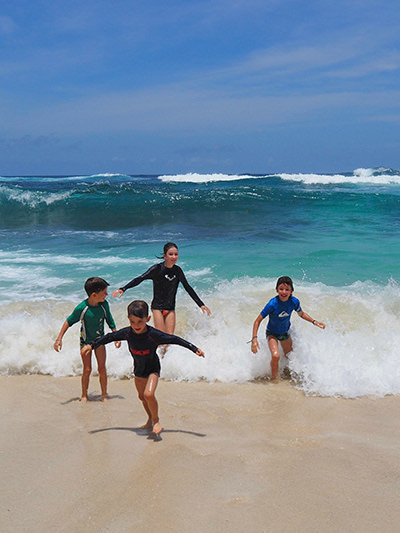
And tomorrow we are going surfing! That was on the list too, and they will try it. They love playing with waves. Let’s see how surfing goes.
They are not afraid, they can all swim. They got washed out on the beach, even the little one, I was really surprised.
When we started the trip, Laurent wasn’t 5 yet, he had to wear little floaters, but after a few weeks he just wanted to try swimming without those, and he has been swimming since then. He can cross the pool underwater, and he is like a little fish right now.
But in a lot of the best moments, Laurent’s best moment was when we went on a hot-air balloon ride in Cappadocia. We got up before sunrise, and we walked in that dark field. We couldn’t see much, but all of a sudden these huge hot-air balloons started filling up and getting lit from the fire, there were these big giant lanterns rising all around us.
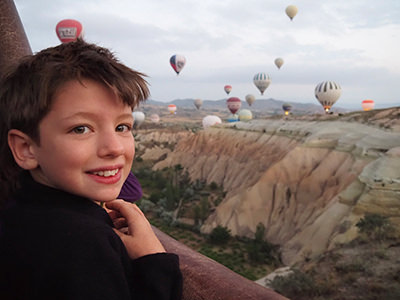
We told the kids that we would see them take off, but that we couldn’t afford to get in them, so they were okay with it. But when we told them we were actually going in, they were so excited. So we got in the hot-air balloon, and it rose slowly as the sun was rising in the valley, with all those hundreds of hot-air balloons, and the color was pinkish, it was just amazing. Even Leo said: “Mommy, it looks like a dream!” And that’s really how it felt, it was so magical.
An American family hit the road with a two-week-old daughter who would, before the age of three, become the youngest person to visit all 63 U.S. national parks. Read the interview with the hiking prodigy - Journey Castillo!
Lemay family voyage to authentic Africa
Kids often have the most sincere but fascinating insights. Are there some specific anecdotes you could tell, quoting your children’s reactions to meeting different cultures?
When we were in Zambia, we were in a village where they didn’t have running water, they had a well. My kids were wowed, they were amazed these people had a well. They thought it was a great thing.
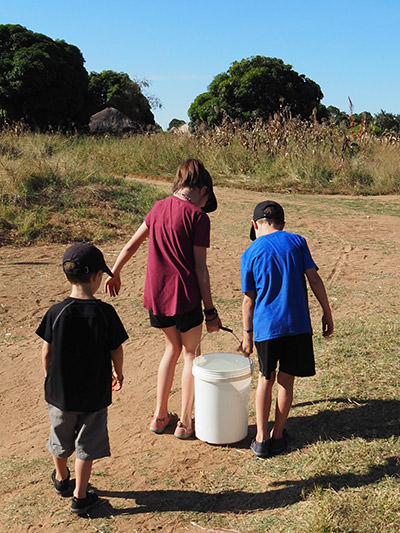
“So okay”, I said. “You think it’s great, here’s this huge bucket, and you need to walk over there, fill it and bring it back.” Just for them to realize it’s really fun to play with a pump for five minutes, but if you need to do it every day, it’s actually a lot of work. So they realized it is not that easy.
But then afterward, my little one was really cute. I asked him what did he think of the village, and he said: “Oh, mum, they are so lucky to have baby goats. I want to live here!”
They don’t see the world the same way. When we met the Masai, he wanted to be a Masai because they told us that men, when reaching a certain age, drink a mix of cow blood and milk just to be strong. So he said: “I want to be a Masai, I want to drink milk and blood, to be strong.” For a long time, he wanted to be a Masai.
Journey through sweet and sour
Laurent’s interest in unusual diets is extraordinary! I would imagine that the world tour with children would be complicated food-wise!
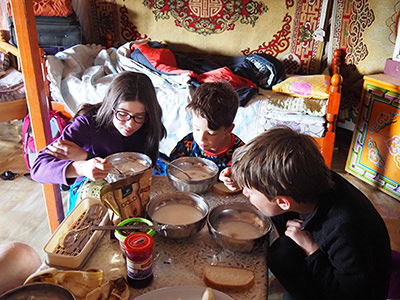
Mongolia was really challenging, for everybody. Especially because they had no vegetables, no fruits, for six weeks… We were able to find pasta and rice, with a few carrots and onions here and there, but we craved some good food.
Indonesia is amazingly good. Turkey was good. Africa was not so bad, it was actually easier than I expected. It was pretty much always the same thing, a lot of chicken and rice, and nshima/ugali, the paste made of maize. I was really worried that our kids would not like it, because it’s all gooey, and you eat it with your hands and dip it in some green sauce or whatever they serve it with. But actually, they loved it. So I was really glad about that.
Throughout the trip, they were pretty good with food.
When I traveled through Ethiopia, I always missed desserts. Traveling through countries without sweets must be a nightmare for Western kids?
Yes, that’s true. Even us as adults, in Africa we were missing sweets. They don’t eat sweet at all there. When we got to Turkey afterward, it was like Christmas! We went crazy for baklavas there. We had enough sweets for a lifetime.
Lessons on privilege and resilience
Of course, traveling through so radically different cultures is a valuable life lesson…
Definitely, we want them to realize on this trip how lucky they are. We have traveled to places where people don’t have electricity or running water, their children cannot go to school, they sometimes don’t have clothes or have really little clothes to put on, no toys.
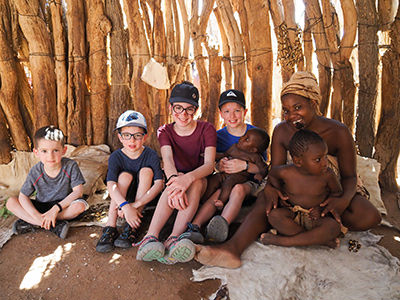
So I wanted them to realize how precious it is to be able to get up in the morning and have good fresh water out of the faucet, that when you look at the planet, they are actually really, really privileged. Their life is quite easy.
Even if their condition is going to make their life a little harder than other people’s, in the big picture they still have a lot. They still have a lot to be grateful for. Also, they have a really nice loving family, and that’s precious.
I want them to see that and appreciate that. Not to focus on the things that are not good in their life, but really on what they could be grateful for.
Do you think this trip can make them stronger?
We want this trip to make them more resilient. With retinitis pigmentosa, what happens is that they will lose their vision, but slowly. So they are going to need to adapt all the time. They will need to adjust all their life.
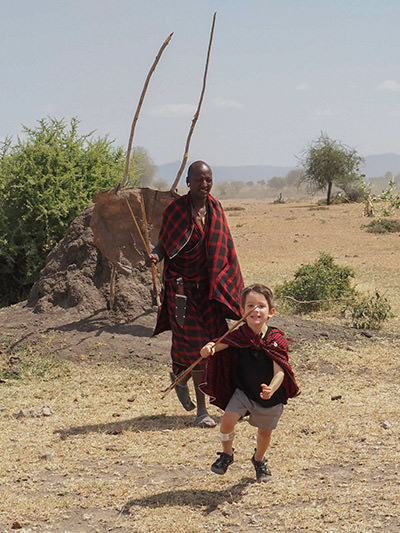
For example, they might be able to drive their car, but after a while, they will have to let that go, because they won’t see well enough. And after a while, they might have to use a cane or a guide dog, because their vision won’t be good enough, and it won’t be safe for them anymore. So it will be constant readjustment, constant adaptation.
They are going to fall down, and they’ll need to get back up and find a solution. So I hope the trip will help them achieve that a little bit.
We are not staying at a 5-star hotel or traveling by a first-class plane. We are visiting little places, and sometimes when you travel, it can really get uncomfortable. There’s frustration, it can be hot, we can be hungry, we can be tired. So they need to adapt all the time. And I hope they get that from the trip. It’s going to help them become a little bit more resilient in life.
And I hope they will learn that when a situation is uncomfortable or unpleasant, if you focus on what’s not good, it doesn’t make it any better, it just makes it worse. While, if you focus on what is good in this situation, even in a bad situation, if you focus on a solution, then it makes things easier, in also that any bad situation will eventually end. And it will get better. It’s just a matter of time. So you need to keep your faith that it will get better at some point.
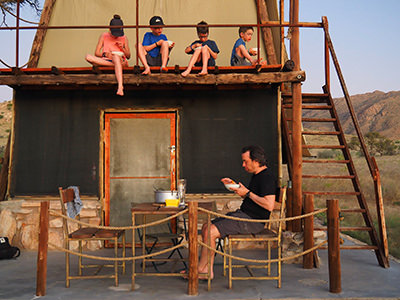
So where do you stay when traveling?
We usually try to sleep in a homestay or a guesthouse. It’s typically family-owned, so we feel the money is going back to the community that way, and it is also a better contact with people.
Sometimes, when you rent on Airbnb, you don’t get to meet the owner, there is nobody there, so I prefer guesthouses.
We find bookings online, but we also get a lot of references in the Family Travel Facebook group. There we get advice “try this family” for anything that is not on the web usually, it’s through a reference in traveling groups.
Childhood on the road
What about the school and other obligations that keep families usually anchored at a particular place?
We homeschool the children, but we really just do the minimum. They are going to be out of school only for a year. We do math and French, just to be sure they will be able to keep up once they get back home. We have the books, and we just follow the program.
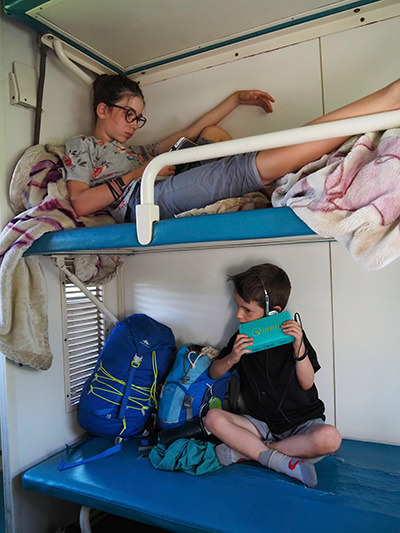
Do they like to read school-unrelated books?
The oldest ones have their reader, so they read e-books. And they actually go through so many books! It is just crazy, because they read all the time, on the bus, at night… They read all the time!
For the youngest ones, we have audiobooks. That’s easier to carry than to have books. We play audio stories, they listen to hours and hours of stories.
They all love fantasy, they love stories with dragons. Harry Potter was a big hit, they read Percy Jackson, all fantasy series, that’s what they really like.
Do they miss their Canadian friends?
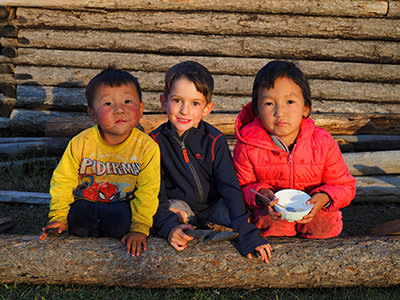
The boys, not at all. I think they are too young for that. But my daughter definitely. Because she is a little older, she misses her friend.
But recently she said: “I miss my friend, but I want to keep traveling forever.” So she is happy. She does FaceTime with her friends once in a while, to keep in touch.
Sometimes, we meet with other families that have kids, so that’s great also, to be able to bond with kids their age.
How about you? Do you miss the social life in Canada?
(Big sigh) I don’t have time to miss it.
Last week, we met some Canadian friends, a family traveling with kids, and we spent a few days together. It was really great to be able to talk. Then I realized I do miss chatting with adults.
My parents also came over, and that was great too. Especially as before the trip we didn’t get to see them that much because of COVID, so I miss my family a bit.
Burden of stuff
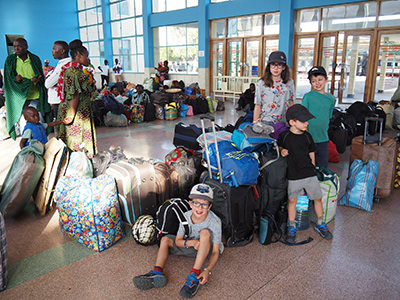
Do you travel with a lot of stuff?
Way too much. Not a lot compared to other families traveling, but we have two backpacks and a carry-on. And kids have little backpacks with their school stuff, little games, and stuffed animals.
It is still too much. I wish we could travel extra light. But with kids, you always want to be safe and comfortable so we carry medication, extra this and that, just to make sure everything is okay.
Do you feel traveling teaches us about minimalism, and that we do not need all these materialistic things left behind?
Yeah, we’ve all been living with three T-shirts each for six months. Like, why do we have so many clothes at home? Why do we change clothes so often? While on the road we say: “Yeah, it kind of looks clean, it doesn’t smell too bad so you can wear it again.”
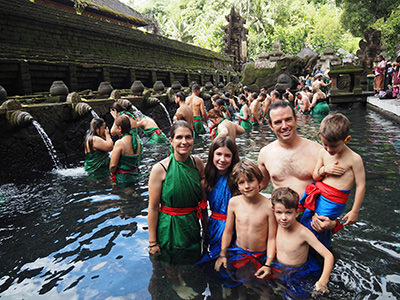
I can imagine it gets more complicated when changing climate zones, from Mongolia to Southeast Asia. Do you get rid of clothes, or get new ones?
When our parents came, we had our coats sent back to Canada. When things get broken, we change them. But we really don’t need to buy new clothes. My kids are skinny, and it’s even hard to find clothes for them.
Now we are shopping for a bathing suit for my daughter, and we are in a Muslim country, so it’s pretty hard. We’ve been to a shopping center, and there is no bathing suit whatsoever. I don’t know where I’m going to find it. Hopefully, at some surf shop around here, I can find something.
Besides photographs, do you take any souvenirs from the places you visit?
We can’t carry anything in our backpacks, we are already full. When we know my parents are coming for a visit, we take little souvenirs we could send by them.
For example, our driver in Mongolia was like family to us, because we spent six weeks with him. He gave us some gifts when we left. We couldn’t just say we don’t want it, and we are going to get rid of it. We kept it and sent it home.
But otherwise, we can’t take physical souvenirs. That’s why I take so many pictures. That’s what will be left of the trip.
Connecting with the world through Instagram and media
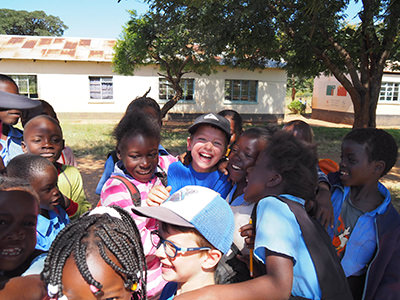
Your children are not the only visually impaired kids exploring the world with you. There is a group of students “traveling” with you in a way, through following your social media stories on Facebook and Instagram Plein Leurs Yeux accounts. How does it work?
That school is really close to our home. The teacher knew about my trip, so she started to follow me on Facebook and share it with her students. She has this huge board where she can project the pictures because some of them still have some vision left.
What they do is they read the post which gives them description and information on where we are, and then the other kids or her describe all the pictures. And they actually often comment on my posts. So that’s pretty cool. Afterward, she shows them the map of the country where we are at.
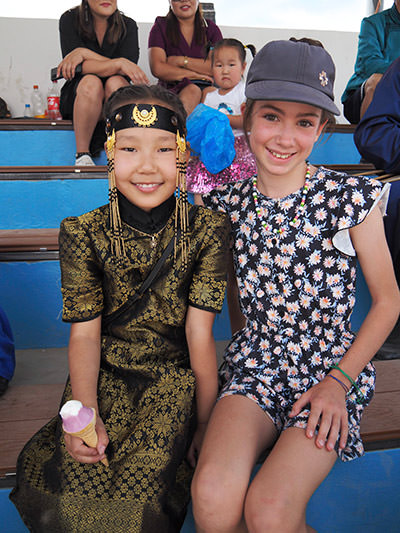
I think it’s a really fun adventure, and of course, I relate to that, I’m just glad to be able to share with them.
Your story connected with many people. It became a great platform for speaking out. But is media attention overwhelming? How do you cope with it?
I did CNN, Sunday Times, People magazine, Global Mail in Canada, I did some news channels all over the world, I’ve been live in Dubai for the news. Honestly, every day I receive dozens of requests. So it’s been totally crazy. I didn’t see that coming at all.
But I am glad to share this story, because of the feedback I get from it. And it’s really surprising that on social media today I receive only good things.
Cures of care
What kind of reactions do you get?
People are reaching out to thank me for sharing the story, or they share their own stories because they are going through similar things. So they are sending me good vibes.
I get a lot of prayers and a lot of recommendations for natural medicine that I should try. That’s a lot sometimes, this whole list of things that could “cure” you from all diseases.
I have people sending something every day. But it all comes from a good place. Even if it’s really weird, people are simply caring. I’m just glad it’s so positive. So that’s why I am happy to share my story because I feel people are getting good from it.
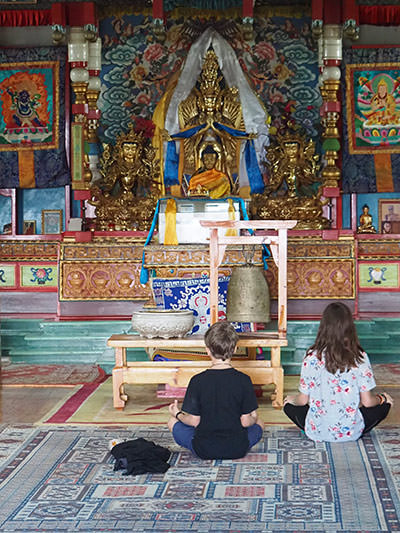
What type of cures do they recommend?
Currently, Ayurvedic medicine apparently does miracles. There is a guy in every country curing you with these. Also, a lot of Bible studies that are supposed to clear everything you have (laughter). Organic barley from Australia that should be able to cure the disease. Oh, sweet potato in lye!
Sometimes, the craziest things I hear, it’s just really weird.
Some people say it comes from the past, that we need to heal the past and consult with this and this to heal their disease.
It’s really actually amazingly interesting what people believe in such a wide range of places. It’s a fun experiment in some ways.
Do you mind if I ask if you are religious?
I don’t mind. But I am not. They are contacting me from many different religions. From Christians to Muslims, Buddhists, and Hindus. It’s really sweet and caring, it is good.
The path to a solution
You do see life beyond “vision or no vision”, you accept it and move forward. I assume people who get confronted with an incurable disease, do get into despair and are rather willing to invest resources into finding any kind of cure that would eradicate the problem. That’s why they support this whole industry of alternative medicines.
Yeah, and for some people it does work. Sometimes, when you believe in something, it does work, just because you believe in it so much. But I trust science too much. So I need to see studies. I’m really a logical person.
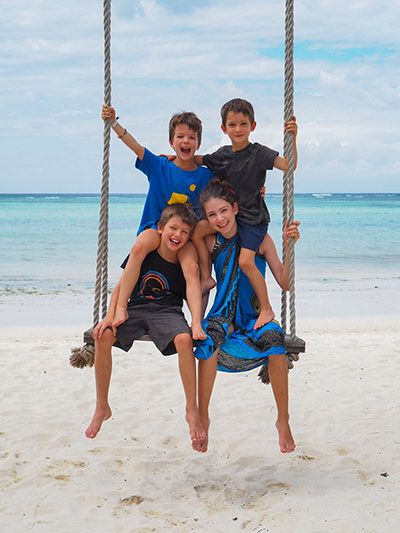
Also, studies don’t tell you if and when the children would completely lose their vision.
Yeah, but the thing is that they are already losing it. So for sure, they’ll lose a good part of it. They might see a little bit. But with central vision, you still need a cane because you’ll bump into people or walls. It’s really hard to go around with just a central vision.
But yeah, we don’t know how long they have, so we’re just going to make the best of it right now.
You know, for them it’s just normal. I never try to approach it as something bad, as something sad in their life. It’s just their path. They have different paths and they’ll be able to rise to the challenge when challenges come.
So they don’t feel sorry for themselves. And I don’t want them to, I’m working really hard for them not to feel sorry for themselves. You know, you just find solutions.
Did you like Edith Lemay and Sebastien Pelletier’s family voyage?
Pin this article for later!
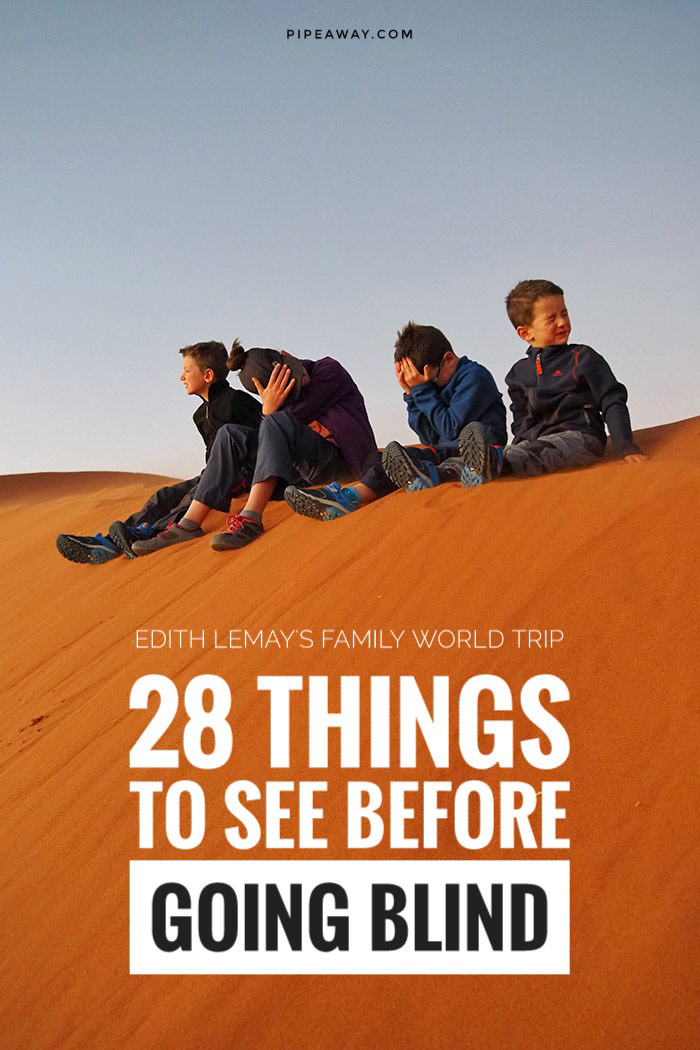
Disclosure: This post may contain affiliate links, which means if you click on them and make a purchase, Pipeaway might make a small commission, at no additional cost to you. Thank you for supporting our work!

